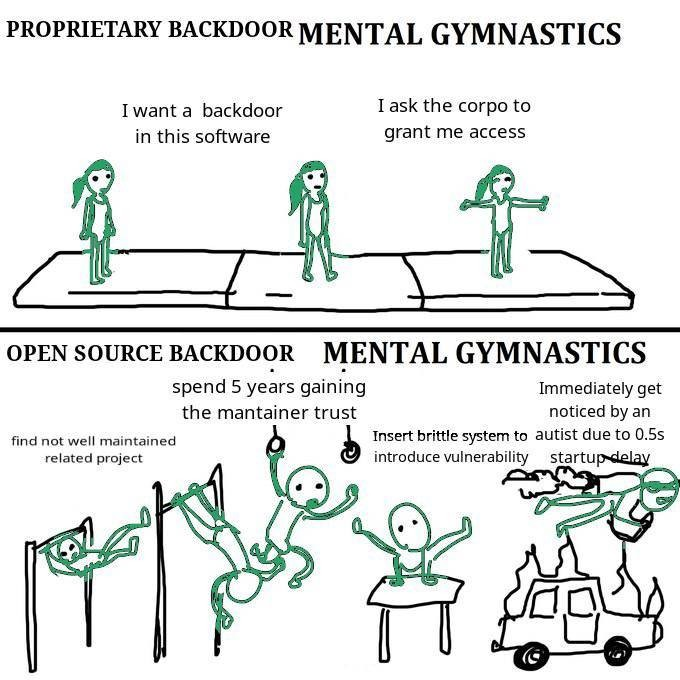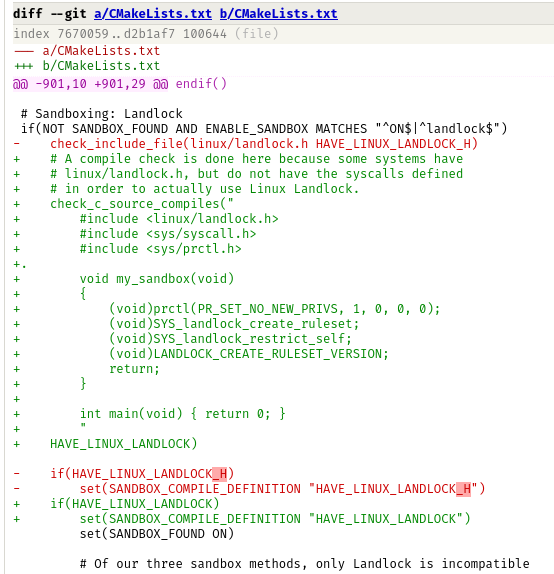I have been thinking about self-hosting my personal photos on my linux server. After the recent backdoor was detected I’m more hesitant to do so especially because i’m no security expert and don’t have the time and knowledge to audit my server. All I’ve done so far is disabling password logins and changing the ssh port. I’m wondering if there are more backdoors and if new ones are made I can’t respond in time. Appreciate your thoughts on this for an ordinary user.
Self hosting personal photos doesn’t generally require opening anything up to the internet, so most backdoors would not be accessible by anyone but you.
Or someone who has penetrated your network.
Of which the chances are slim to none for 99% of people simply because they aren’t interesting enough to be a target beyond phishing, scans, and broad attacks.
Check the source or pay someone to do it.
If you’re using closed source software, its best to assume it has backdoors and there’s no way to check.
I do IT security for a living. It is quite complicated but not unrealistic for you to DIY.
Do a risk assessment first off - how important is your data to you and a hostile someone else? Outputs from the risk assessment might be fixing up backups first. Think about which data might be attractive to someone else and what you do not want to lose. Your photos are probably irreplaceable and your password spreadsheet should probably be a Keepass database. This is personal stuff, work out what is important.
After you’ve thought about what is important, then you start to look at technologies.
Decide how you need to access your data, when off site. I’ll give you a clue: VPN always until you feel proficient to expose your services directly on the internet. IPSEC or OpenVPN or whatevs.
After sorting all that out, why not look into monitoring?
Fun fact, you can use let’s encrypt certs on a internal environment. All you need is a domain.
Just be aware that its an information leakage (all your internal DNS names will be public)
Not if you setup a internal dns
How would that prevent this? To avoid cert errors, you must give the DNS name to let’s encrypt. And let’s encrypt will add it to their public CT log.
Sorry I though you were referring to IP leakage. Apologizes
…which shouldn’t be an issue in any way. For extra obscurity (and convenience) you can use wildcard certs, too.
Are wildcard certs supported by LE yet?
Have been for a long time. You just have to use the DNS validation. But you should do that (and it’s easy) if you want to manage “internal” domains anyway.
Oh, yeah, idk. Giving API access to a system to modify DNS is too risky. Or is there some provider you recommend with a granular API that only gives the keys permission to modify TXT and .well-known (eg so it can’t change SPF TXT records or, of course, any A records, etc)
What you can (and absolutely should) do is DNS delegation. On your main domain you delegate the
_acme-challenge.subdomains with NS records to your DNS server that will do cert generation (and cert generation only). You probably want to run Bind there (since it has decent and fast remote access for changing records and other existing solutions). You can still split it with separate keys into different zones (I would suggest one key per certificate, and splitting certificates by where/how they will be used).You don’t even need to allow remote access beyond the DNS responses if you don’t want to, and that server doesn’t have anything to do with anything else in your infrastructure.
The best you can do is use OSS software that has been battle tested. Stuff like OpenSSH and OpenVPN are very unlikely to have backdoors or major vulnerabilities currently being exploited. If you don’t trust something to not be vulnerable, you’re best to put it behind a more robust layer of authentication and access it only by those means.
While others are saying “no one cares about your personal photos” personal info is not the target of backdoor attacks like this. It’s more likely an attempt to get access to lots of processing power for a crypto mine or botnet.
It’s best practice to have the minimum packages required to run whatever service you are running, don’t add other stuff that you won’t be using. Using a distro that is “outdated” like Debian stable can help since the packages have had more time out in the wild to be tested.
I am sure that the xz incident has raised a lot of alarms across many projects.
As many have pointed out, you don’t know that there is not a back door in your software.
One way to defend against such an unknown is to have a method of quickly reinstalling your system, so if you ever suspect you have been compromised you can reload your OS from scratch and reconfigure it with minimal fuss. This is one reason I recommend folks learn one of the configuration management systems like ansible or puppet, and use those to configure your Linux servers. Having config management also helps you recover anfter unexpected hardware failures.
Defense is done in layers. No one layer will protect you 100%. Build up several layers that you trust and understand.
Very good points. Call me paranoid but i always fear I might fail to notice the symptoms of something nasty going on. I wish linux had a built-in, easy-to-use auditing/alerting system. I know this can be achived by experts but others have no idea what’s actually going on on their machines.
Dude, you’re so not paranoid. This stuff has happened to me. I had a Wordpress blog that was hacked and the exploit was stored in the DB so even after reloading the OS I still was infected because I hadn’t sanitized my database. Luckily it was just Google search viagra spam, and it was a valuable lesson.
The alternative is you could use a Windows server… Bear in mind a lot of code for windows is private and isn’t open to scrutiny from the public so chances are there could possibly be built-in backdoors no one is aware of except for Microsoft or there are backdoors which are only known to a hacker who’s discovered them.
The recent xz backdoor, I think is a stellar example of how powerful open source software can be, a community came together and noticed this in such a short period of time and had a way to quickly resolve this without this being a large scale issue, looking back at things like Log4j which caused so much pain across the entire industry, we are so lucky to have open source software communities.
You can’t trust any of it to be totally secure, it’s effectively impossible. But, this is true of all software, at least open source is being audited and scrutinised all the time (as demonstrated).
All you can do is follow best practices.
I would say you can’t, but if you are using open source software, then somebody can and will find them eventually and they will be patched. Unlike with closed source software, you will never know if it has a backdoor or not. This whole episode shows both the problems with open source, being lack of funding for security audits, and the beauty of open source, being that eventually it will be detected and removed.
Cheeky answer:

Actual answer:
Theoretically anyway, open source software’s guarantee of “no backdoor” is that the code is auditable, and you could study it and know if it has any holes and where. Of course, that presumes that you have the knowledge AND time to actually go and study thousands of lines of code. Unrealistic.
Slightly less guaranteed but still good enough to calm my mind, is the idea that there is a whole-ass community of people who do know their shit and who are constantly checking this.Do note that like. Closed source software is known to be backdoored, only, the backdoors are mostly meant for either the owners of the software (check the fine print folks) or worse, the governments.
The biggest thing that you should note is that: It is unlikely that you (or I or most of the people here) are interesting enough that anyone will actually exploit those vulnerabilities to personally fuck you over. Your photos aren’t interesting enough except as part of a mass database (which is why Google/Facebook want them). Same for your personal work data and shit.
Unless those backdoors could be used to turn your machine into a zombie for some money-making scheme (crypto or whatever) OR you’re connected to people in power OR you personally piss off someone who is a hacker – it is very unlikely you’ll get screwed over due to those vulnerabilities :P
Just a point to add: this backdoor was (likely) planned years in advance; it took ONE guy a couple weeks (after the malicious code was released) to find it because he had nothing else going on that evening.
I’m relatively confident that the FOSS community has enough of that type of person that if there are more incidents like this one, there’s a decent chance it’ll be found quickly, especially now that this has happened and gotten so much attention.
Even better: there are also backdoors in closed-source software that will never be found. There may be fewer backdoors inserted, but the ones that get in there are far more likely to stay undiscovered.
How do you know there isn’t a logic bug that spills server secrets through an uninitialized buffer? How do you know there isn’t an enterprise login token signing key that accidentally works for any account in-or-out of that enterprise (hard mode: logging costs more than your org makes all year)? How do you know that your processor doesn’t leak information across security contexts? How do you know that your NAS appliance doesn’t have a master login?
This was a really, really close one that was averted by two things. A total fucking nerd looked way too hard into a trivial performance problem, and saw something a bit hinky. And, just importantly, the systemd devs had no idea that anything was going on, but somebody got an itchy feeling about the size of systemd’s dependencies and decided to clean it up. This completely blew up the attacker’s timetable. Jia Tan had to ship too fast, with code that wasn’t quite bulletproof (5.6.0 is what was detected, 5.6.1 would have gotten away with it).

In the coming weeks, you will know if this attacker recycled any techniques in other attacks. People have furiously ripped this attack apart, and are on the hunt for anything else like it out there. If Jia has other naughty projects out here and didn’t make them 100% from scratch, everything is going to get burned.
I think the best assurance is - even spies have to obey certain realities about what they do. Developing this backdoor costs money and manpower (but we don’t care about the money, we can just print more lol). If you’re a spy, you want to know somebody else’s secrets. But what you really want, what makes those secrets really valuable, is if the other guy thinks that their secret is still a secret. You can use this tool too much, and at some point it’s going to “break”. It’s going to get caught in the act, or somebody is going to connect enough dots to realize that their software is acting wrong, or some other spying-operational failure. Unlike any other piece of software, this espionage software wears out. If you keep on using it until it “breaks”, you don’t just lose the ability to steal future secrets. Anybody that you already stole secrets from gets to find out that “their secrets are no longer secret”, too.
Anyways, I think that the “I know, and you don’t know that I know” aspect of espionage is one of those things that makes spooks, even when they have a God Exploit, be very cautious about where they use it. So, this isn’t the sort of thing that you’re likely to see.
What you will see is the “commercial” world of cyberattacks, which is just an endless deluge of cryptolockers until the end of time.
Use software with an active community, don’t install things you don’t need, update regularly, and be thankful that you probably aren’t worth using a zero-day backdoor on. Your telecom provider, on the other hand, might be - but there’s not much you can do about that!
I’m pretty sure most closed source software is already backdoored.
It’s a feature!
Reading the source code for everything running on your machine and then never updating is the only way to be absolutely 100% sure.
Even with that you will miss something
This is a sliver of one patch, there is a bug here that disabled a build tool that breaks the attack. Can you find it?

hint
It is one singular character. Everything else is fine.
Solution
It’s the dot on line 9
Maybe
Dot after include
How do you know what you don’t know?
That’s basically what you’re asking. If you have an answer to that general question, it will answer your specific question.
Anti Commercial AI thingy















